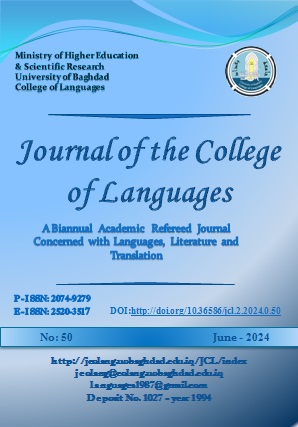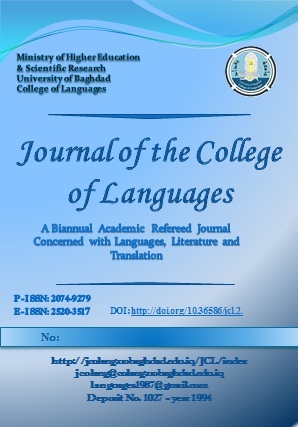A comparative study of the motif of love in the poems of Nizar Qabbani and Saadi Shirazi
بررسی تطبیقی موتیف عشق و صورتبندی آن در اشعار سعدی شیرازی و نزار قبانی
DOI:
https://doi.org/10.36586/jcl.2.2024.0.50.0169Keywords:
love, romantic poetry, Nizar Qabbani, Saadi Shirazi., عشق، شعر عاشقانه، نزار قبانی، سعدی شیرازی.Abstract
Now days many researches are done in the field of humanities related to comparative literature which will open new windows in the category of criticism. the present study deals with the comparative study of the concept of love , which is one of the most mysterious concepts in literature world , in the poetry of the 7th century poet saadi shirazi and the contemporary Syrian romance nazar qabbani.in the order to increase the accuracy of the research on the concept of love from the aspect of antiquity, purity or sensuality, entering in terms of social issues, its role in human excellence, its inaccessibility and the circle of inclusion, it was examined how these two poets view the concept of love in terms of the six indicators mentioned. The author of these research came to the conclusion that despite the time and cultural difference between saadi shirazi and nazar qabbani . their view of love is similar , which is an eternal concept, innocently inaccessible , universal and as a factor to deal with todays issues of community and human connection to the world have meaning.
چکیده
بررسی موتیف به عنوان یک استراتژی تحلیل و تجزیه اثر هنری در مطالعات نقد ادبی رواج دارد که پژوهش در این زمینه منجر به شناخت سطوح متفاوت اندیشه و جنبههای ساختاری و محتوایی اثر هنری میشود. امروزه پژوهشهای بسیاری در حیطهی علوم انسانی در حوزهی ادبیات تطبیقی صورت میپذیرد که موجب گشوده شدن پنجرههای جدیدی در مقولهی نقد ادبی خواهد شد. پژوهش حاضر با روش تحلیل محتوا به بررسی تطبیقی مفهوم عشق که یکی از پررمز و رازترین مفاهیم در ادبیات جهان است در شعر سعدی شیرازی شاعر قرن هفتم و نزار قبانی عاشقانهسرای معاصر سوری میپردازد. سعدی و نزار قبانی از لحاظ زمانی هم عصر نبودهاند اما موضوع موتیف عشق یکی از مهمترین مباحث اثر هنری آنها به شمار میآید و در واقع این موتیف هسته مرکزی و وجه غالب مشترک آثار این دو شاعر است. به همین جهت آنها به عنوان مورد مطالعه قرار گرفتند. به منظور افزایش دقت پژوهش مفهوم عشق از جنبهی قدمت، پاک یا شهوانی بودن، ورود به حیطهی مسائل اجتماعی، نقش آن در تعالی انسان، صعب الوصول بودن و دایرهی شمول مورد بررسی قرار گرفت که نگاه این دو شاعر به مفهوم عشق به لحاظ شش شاخصهی مذکور چگونه است. از رهگذار این پژوهش این نتیجه حاصل گردید که با وجود اختلاف زمانی و فرهنگی بین سعدی شیرازی و نزارقبانی نگاه آن دو به عشق نگاهی مشابه است که آن را مفهومی ابدی، معصومانه، صعب الوصول، جهانشمول و به منزلهی عاملی برای پرداختن به مسائل روز اجتماع و اتصال انسان به عالم معنا میدانند.
References
Eslami Nodooshan, Mohammad Ali (1389) Four Iranian Spokesman, Tehran: Qatreh.
Plato (1336) five treatises (M. Sanei, Trans.) Tehran: Persian Books Translation and Publish Firm.
Allendy, René (1373) The Love (J. Sattari, Trans.), first edition, Tehran, Tous Publishers.
Bahrami, Razieh & Nosrati, Abdullah (1395 S.H) Comparative Analysis of Love in Sonnets of Rumi, saadi and Hafez, Baharestan-e-Sokhan scientific and investigative quarterly, No.34,67 to 82.
Hassanli, Kavoos (1386) Saadi’s pure approach, saadiology journal, No. 12,39 to 51.
Hamidian, Saeed (1388) Unfair Aspersions against Saadi, Saadiology Journal, No.12, 39 to 51.
Dehghanian Javad & Mallahi, Ayesheh (1392) Comparative analysis of Romantic themes in F. Moshiri & Nizar Qabbani Pieces, Comparative Literature Journal, No.8, 89 to 117.
Rabat, Majid Merhej )2009), Common ideas and concepts in Arabic and Persian literature, Journal of the College of Languages, Issue 19, Pages 117-135.
Rastegar Fasaei, Mansour (1379) The Narration of Love, Saadiology Journal, No.3, 7 to 22.
Roumiani, Behrouz & Bakhshizade, Masoumeh & Qolami, Hamideh (1394) transcendent beloved in Shamlou and Nizar Poetry, Comparative Literature Studies Journal, No.36, 27 to 50.
Suhrawardi, Shahab Ad-Din (1384) Sum of Literary Works of Master of Illumination (Sheikh Al-Ishraq), Correction, panel and Introduction by Nasr, Hossein, Tehran: Iranian Scientific Research Institute.
Shamisa, Sirus (1370) course of poetry in Persian language Tehran: Ferdous.
Shaffer, Lawrence.(2005).Encyclopedic Dictionary of Literary Criticism. Delhi:IVY Publishing House.
Shirazi, Saadi (1342) Saadi’s sonnet Divan (Foroughi, Mohammad Ali correction edition.), Tehran: Sepehr.
Safar,Hasan Ali (2020), The composition of the vocabulary and passages in the poems of Saadi Journal of the College of Languages, No.(41), Pg.224-245.
Atash, Abd al-Reza & Peysepar, Elahe (1392) Image of Women in Nizar Qabbani & Forough Farahzad poetry, Comparative Literature Studies Journal, No.27, 83 to 105.
Al-Oqbavi, Ismael (1401) The Divan of Nizar Qabbai Analysis, (R. Jalili Gilande, P. Mohammadi, M. Mahmoudi, Trans.) Tehran: Shab Afrouz.
Qabbani, Nizar. (1998 A.D) perfect Poetical verbs, Lebanon: publications of Nizar Qabbani.
…(1384 S.H) Beirut, Love and Rain, (R. Ameri, Trans.), Tehran: Negima.
…(1384 S.H) Beirut, Love and Rain, (R. Ameri, Trans.), Tehran: Negima.
…(1384 S.H) So that I become green of love (M. Aswar, trans.), Tehran: Sokhan.
… (1384 S.H) The Love Repubblica (M. Asakere pour, trans. K. Abedini Motlaq Cooperation.), Tehran: Afarinesh.
… (2003) The Wonders of Nizar Qabbani, Beirut: House of Wonders for publishing and distribution.
… (1386 S.H) Love Doesn’t Stop Behind the Red Light (M. Sarhadi, Trans.), Tehran: Kelidar.
… (1980 A.D) Book of Drawing with words, Lebanon: Beirut.
… (1992 A.D) There’s no dominant but love, Lebanon: Beirut
… (1973 A.D) La Poetry Collection, Lebanon: Beirut..
Qeisarian, Eshagh & Zahedi-e-mazandarani, Mohammad Javad & Mehrayin, Mostafa & Maleki, Amir (1396) Love studies at psychological, Sociological, philosophic; presenting a synthetic theory, Social Psychology Researches Journal, No.27, 55 to 82.
Kaboutari, Javad (1398) Comparative Analysis of Metaphorical Love in Hossein Monzavi and Nizar qabbani’s Poetry, Comparative Literature Studies Quarterly, No.52,311 to 340.
Mohseninia, Naser & Yasdan Panah, Robabeh (2009 A.D) Comparative Analysis of Image of Women in Ahmad Shamlou and Nizar Qabbanis’ Pieces, Arabic Studies Journal, No2, 343-372.
Modarres Zade, Abd Al-Reza & Safavi, Banafsheh Sadaat (1390) a View of Ethical Lessons in Saadi’s Sonnets, Educational Literature bulletin, No23,127 to 148.
Momtahen, Mahdi & Khoshkalam, Leila (1392) Romantic poetry themes Analysis in Pieces of Fereidoun Moshiri and Nizar Qabbani, Comparative Literature Studies Journal, No.27, 53, 81.
Movahhed, Zia (1378) Saadi, Tehran: Niloufar.
Mirghaderi, Seyyed Fazlollah & Dehghan, Mahnaz (1390) Manifestations of Love in Nizar Qabbani’s Poetry, Literary and Stylistics Researchs Journal, No.4, 187 to 218.
Nuaimi, Murad Kazem Farhan (2013), The binary opposition (good versus evil) in Persian poetry (An analytical study), Journal of the College of Languages, Issue 27, Pages 91-105.
Yousefi, Qolamhossein & Bakkar, Yusuf Hossein (1397) The Story of Nizar and I, Tehran: Tous publishers, Frankfurt, H. (1999). Autonomy, Necessity, and Love, In Necessity, Volition and Love, Cambridge: Cambridge University Press, 129-141.
Frankfurt, H. (1999). Autonomy, Necessity, and Love, In Necessity, Volition and Love, Cambridge: Cambridge University Press, 129-141.
Seigneuret, Jean-Charles. (1988). Dictionary of literary Themes and Motifs. New York: Greenwood prees.
Cuddon, J.A. (2006). A Dictionary of literary Terms and Literary theory. Malden: Black Well Publisher
Downloads
Published
Issue
Section
License
Copyright (c) 2024 Journal of the College of Languages (JCL)

This work is licensed under a Creative Commons Attribution 4.0 International License.










